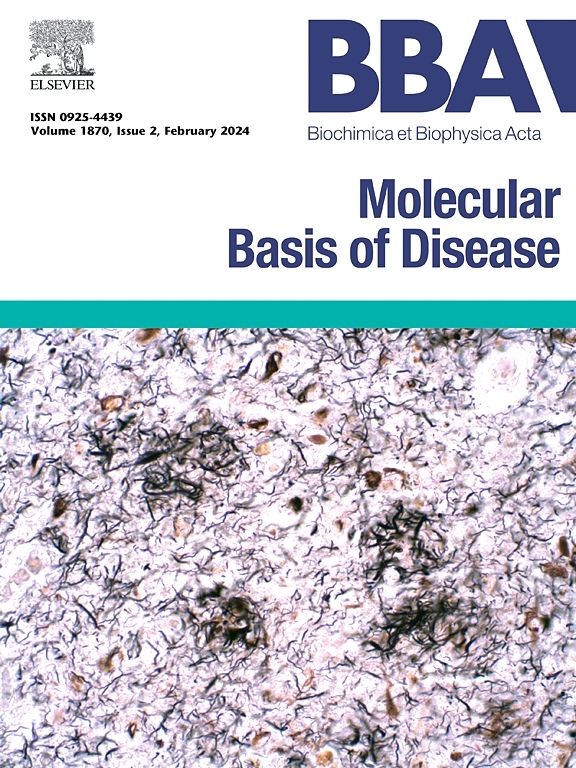Intrinsic amyloid deposition following proteostasis impairment in osteoarthritic chondrocytes: Insights and therapeutic approaches
IF 4.2
2区 生物学
Q2 BIOCHEMISTRY & MOLECULAR BIOLOGY
Biochimica et biophysica acta. Molecular basis of disease
Pub Date : 2025-04-26
DOI:10.1016/j.bbadis.2025.167865
引用次数: 0
Abstract
Osteoarthritis (OA) is the most common age-related and degenerative joint disease. Proteostasis and protein quality control (autophagy, unfolded protein response, and the ubiquitin-proteasome system) are pivotal for cellular homeostasis and their impairment leads to protein misfolding and amyloid deposition in aged tissues. We here investigated amyloid deposition in OA. Amyloid fibrils were observed in chondrocytes in ex vivo cartilage samples. The underlying mechanisms were assessed in vitro: chondrocytes and cartilage organ cultures were treated with chloroquine and/or lipopolysaccharide for assessment (Western Blotting, immunohistochemistry, histochemistry cytofluorimetry) of amyloid deposition after induction of ER stress with/without blockage of autophagy. Overall, our data show for the first time that proteostasis impairment leads to intrinsic amyloid deposition in OA chondrocytes. These effects were mitigated by selected polyphenols. In conclusion, amyloidosis could contribute to OA progression, and the failure of proteostasis, a hallmark of aging, represents a promising therapeutic target.

骨性关节炎软骨细胞蛋白平衡损伤后的内在淀粉样蛋白沉积:见解和治疗方法
骨关节炎(OA)是最常见的与年龄相关的退行性关节疾病。蛋白质平衡和蛋白质质量控制(自噬、未折叠蛋白反应和泛素-蛋白酶体系统)是细胞稳态的关键,它们的损害导致衰老组织中蛋白质错误折叠和淀粉样蛋白沉积。我们在此研究OA中的淀粉样蛋白沉积。离体软骨标本软骨细胞中可见淀粉样原纤维。在体外评估其潜在机制:用氯喹和/或脂多糖处理软骨细胞和软骨器官培养物,以评估(Western Blotting、免疫组织化学、组织化学细胞荧光法)诱导内质网应激后淀粉样蛋白沉积,并阻断/不阻断自噬。总的来说,我们的数据首次表明,蛋白平衡障碍导致骨性关节炎软骨细胞内固有淀粉样蛋白沉积。选定的多酚减轻了这些影响。总之,淀粉样变可能促进OA的进展,而蛋白质平衡的失败(衰老的标志)代表了一个有希望的治疗靶点。
本文章由计算机程序翻译,如有差异,请以英文原文为准。
求助全文
约1分钟内获得全文
求助全文
来源期刊
CiteScore
12.30
自引率
0.00%
发文量
218
审稿时长
32 days
期刊介绍:
BBA Molecular Basis of Disease addresses the biochemistry and molecular genetics of disease processes and models of human disease. This journal covers aspects of aging, cancer, metabolic-, neurological-, and immunological-based disease. Manuscripts focused on using animal models to elucidate biochemical and mechanistic insight in each of these conditions, are particularly encouraged. Manuscripts should emphasize the underlying mechanisms of disease pathways and provide novel contributions to the understanding and/or treatment of these disorders. Highly descriptive and method development submissions may be declined without full review. The submission of uninvited reviews to BBA - Molecular Basis of Disease is strongly discouraged, and any such uninvited review should be accompanied by a coverletter outlining the compelling reasons why the review should be considered.

 求助内容:
求助内容: 应助结果提醒方式:
应助结果提醒方式:


